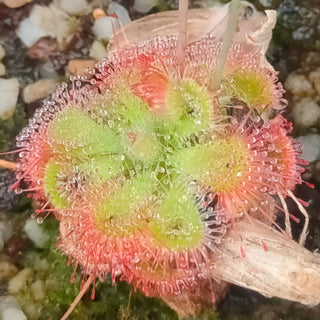Aster alpinus
GOLIATH ASTER ALPINE
- Unit price
- / per
Very large Alpine Aster flowers with extra petals, or double-petalled!
Aster alpinus (Alpine aster) is an ornamental plant native to the mountains of Europe (including the Alps), with a subspecies native to Canada and the United States.
It grows to be about 6-12 inches tall (15-30 cm). The bloom color may be pink, violet-lavender, dark purple-black, or white-near white and may bloom in late spring or early summer or, occasionally, midsummer. In the UK this plant has gained the Royal Horticultural Society's Award of Garden Merit.
It does better in generally cooler climates. Usually it is adapted to clay, silt, loam, silty clay, sandy clay, clay loam, silt loam, sandy loam, silty clay loam and sandy clay loam soils, and prefers low fertility. The plant can tolerate a minimum temperature of -28 C / -18. It can survive medium heat of fire. It is herbaceous and attractive to bees, butterflies, and birds.
Type: Hardy Perennial
Height: 30cm, 12"
Location: Sun or part sun
Hardiness zones: 3-7
Seeds per packet: 15
Surface sow as light aids germination. Water the seeds in. Temperature 20-22C (68-72F) for 4 weeks. If they have not germinated after 4 weeks then a cooling period is required. Cover them with plastic and place in a fridge for 4 weeks. Be sure they stay moist. After the cold stratification period they are then brought back to a cool room (15C, 59F) for them to germinate. Germination can be 30-60 days after the warming period, though some will take longer.
Ornamental use only. These seeds and or plants are poisonous.
Aster alpinus
GOLIATH ASTER ALPINE
- Unit price
- / per
Multiple secure payment options available.
Adding product to your cart
You may also like
Very large Alpine Aster flowers with extra petals, or double-petalled!
Aster alpinus (Alpine aster) is an ornamental plant native to the mountains of Europe (including the Alps), with a subspecies native to Canada and the United States.
It grows to be about 6-12 inches tall (15-30 cm). The bloom color may be pink, violet-lavender, dark purple-black, or white-near white and may bloom in late spring or early summer or, occasionally, midsummer. In the UK this plant has gained the Royal Horticultural Society's Award of Garden Merit.
It does better in generally cooler climates. Usually it is adapted to clay, silt, loam, silty clay, sandy clay, clay loam, silt loam, sandy loam, silty clay loam and sandy clay loam soils, and prefers low fertility. The plant can tolerate a minimum temperature of -28 C / -18. It can survive medium heat of fire. It is herbaceous and attractive to bees, butterflies, and birds.
Type: Hardy Perennial
Height: 30cm, 12"
Location: Sun or part sun
Hardiness zones: 3-7
Seeds per packet: 15
Surface sow as light aids germination. Water the seeds in. Temperature 20-22C (68-72F) for 4 weeks. If they have not germinated after 4 weeks then a cooling period is required. Cover them with plastic and place in a fridge for 4 weeks. Be sure they stay moist. After the cold stratification period they are then brought back to a cool room (15C, 59F) for them to germinate. Germination can be 30-60 days after the warming period, though some will take longer.
Ornamental use only. These seeds and or plants are poisonous.
















































